 Sámegillii
Sámegillii
Article in the book Sami School History 1. Davvi Girji 2005.
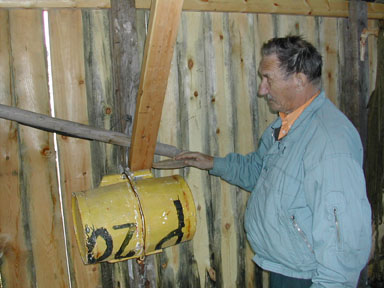 In Smørfjord, where Johan Johannessen once received his two years of school, the culture of the coast Sámi is regaining honour and esteem following the opening, in 2004 of a coast Sámi square. Here is Johan in the boathouse, showing and explaining old fishing tackle. |
Johan Johannessen from Porsanger is one of those who, due to the war, received very little schooling. Despite the fact that he neither learnt to read and write his mother tongue, Sami, nor the language of instruction, Norwegian, his claim for compensation was rejected. This is his own story, in which he tells of his upbringing, of school and of the problems that his lack of schooling has led to later in life. The story was first put down on paper by Else Samuelsen and was used as the basis of a claim for compensation for lost schooling. The story has later been edited by Svein Lund in co-operation with Johan Johannessen. In addition to Johan Johannessen’s story we have also included the reply from “The Committee on Indemnities”. |
My childhood home, before the war, was at the outermost point of Bringnes, about 10 kilometres from the nearest postal village, Russenes. Bringnes is a peninsula that lies between Olderfjord and Smørfjord. I was the eldest of three siblings. My parents made a living, as did many others in those days, from a combination of smallholding, fishing, hunting, gathering and home-industry. Home-industry consisted of clothes, principally for the family’s own needs but with a small part for sale as well.
I had my seventh birthday in 1938 and started school that same year. The school was in Smørfjord. We went to boarding-school and “turn-school” as it was known at the time. That is to say that we attended school for a few weeks and then, as a rule, had the corresponding number of weeks off.
The language spoken at home was Sami and I neither understood nor spoke Norwegian. Our teacher was called Elida Thommassen and came from Elverum. She was married to somebody from the municipality and consequently lived here. She couldn’t speak Sami so those pupils who could speak a little Norwegian had to help us others by translating what the teacher said into Sami. The head teacher, who was also director of the boarding-school, couldn’t speak Sami either. We weren’t allowed to speak Sami, but what were we supposed to speak then when that was all we knew? Gradually I learnt a little Norwegian but I got a lot wrong and the others laughed at me when I spoke the little I knew.
I can’t remember when school was suspended because of the war. It may be surmised that I had 2 years of schooling at the most, it’s not improbable that it was even less. At school I was bullied, beaten and kicked, and when the school was closed I was just glad I didn’t have to go there.
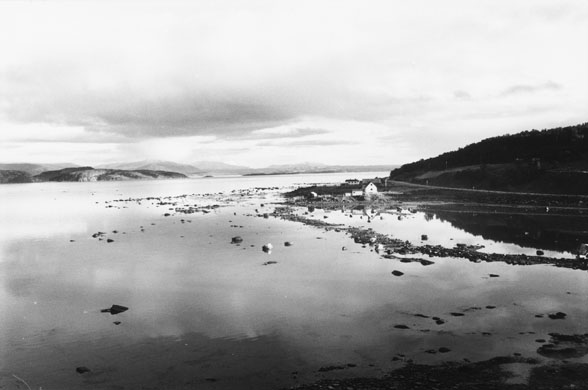
| Leavdnjavuotna / Porsangerfjorden
(Photo: Hanna H. Hansen) |
We were forcibly evacuated in the autumn of 1944. First we were sent to Billefjord from where we continued our journey on the famous German cargo ship “Karl Arp.” There were terrible conditions on board and it was a tough experience for me as well as I was 13 years old at the time and had a clear understanding of the situation. This journey to Narvik has been painful to recall. I’ve tried to push it to the back of my mind, tried not to think about it. In that way I’d stop the memories “ruining” my day-to-day life. But it hasn’t been easy.
When we arrived in Narvik, we stayed initially in a railway-shed. Before Christmas we moved to Hamarøy, more precisely to the postal address Tranøy and the village of Røssnes, where we were given lodgings at a farm. We got two small rooms upstairs that had been used as bedrooms before we arrived, but when we came a stove and cooking utensils were put in so that we could make our own food. We stayed there for one and a half years.
During the time we were there I received no offer of schooling. I have come to understand that it was because of my poor knowledge of Norwegian that I didn’t get any schooling.
In July of 1945 we travelled north on a small 50 foot cargo boat. In Finnmark we were met by burnt-down villages, which was the state in which we found our own village. It was a painful sight for many. People cried tears of joy for a free country and for being back home again, but they also cried tears of sorrow because everything they had owned was burnt. Only the foundations remained as proof that a home had once stood there. In those days there was no crises counselling to help people. Everybody had to manage as best they could. You were your own Psychologist and Psychiatrist. Experiences were suppressed, which is precisely what you should NOT do, according to today’s received wisdom.
For the first two months we lived in a tent, but to be able to meet the winter in Finnmark we built a turf-hut, where we lived for two years. On the end of the hut we lived in was put an “extension” for domestic animals. We had a sheep that we had got from our hosts in Røssnes and that we had taken with us to Finnmark. Later, families got both sheep and cows. We got a cow. It was relief for families in Finnmark, so that they would have something to start with. Small boats and fishing-tackle were also distributed. The Finnmark Office later provided prefabricated houses that were put up by contracted joiners, the so-called “rebuilding-houses”. When we moved into our house, the turf-hut was altered and adapted to make a better shed for the animals.
I was erased from the census directly after the war. It was my father who had to attend to a matter at the municipal offices. There he was informed that they had registered a family of four. – But there are five of us, said my father. - No, said the people at the municipal offices, we have been informed that your eldest son died while you were evacuated. – That’s strange, said my father, - he was most certainly still alive when I left the house today. The matter was subsequently resolved and today I am registered as an inhabitant of the municipality of Porsanger.
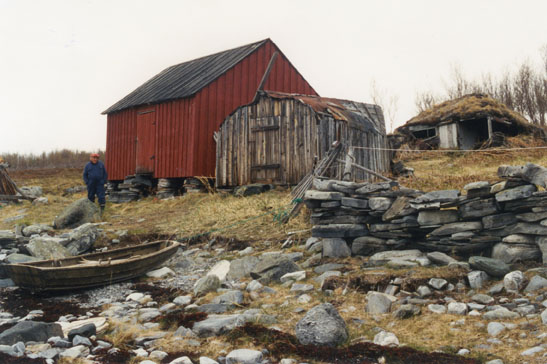
|
After the war, Johan and his family lived first in a tent, then in a turf-hut. There are no pictures of that turf-hut, but this picture of another turf-hut at Bringnes says a lot about what living conditions have been like along the Porsanger Fiord. Half of an old Nordlands boat has been used as a roof for the turf-hut, while the other half has gone to make the tool-shed.
(Photo: Arvid Petterson / Porsanger bygdebok) |
I didn’t get any schooling after the war as by then I was 15 years old and over the compulsory school age. There was an offer of remedial schooling, but I couldn’t afford to go to school, because firstly, as the eldest son, I had to help provide for the family, and there were no school grants in those days. Secondly, I didn’t dare either because I knew so little and still didn’t understand Norwegian very well. My brothers went to school after the war and I tried to learn something by following what they did. In this way I learnt to read Norwegian after a fashion.
I lived in my childhood home until I started my own family. At that time it wasn’t unusual for adult children to live with their parents. Neither was it unusual for the children to help on the farm, as part of the combination of subsistence farming, fishing and hunting that people were used to in those days. In this way I also made my living, with a combination of farming, fishing and hunting. There weren’t any other possibilities for somebody with lost schooling. For some reason or other I couldn’t get any work on land. I wasn’t accepted. At school I had been bullied. My father got a nickname due to his being a keen hunter, and this name followed me. Most people saw something negative in this. Now, looking back, I just find the whole thing rather comical. As a youth, growing up, I was physically quite weak and lacked strength in a number of areas though I was never ill in that sense. I lacked strength, but I managed to develop myself in this area through hard work at sea in all kinds of weather.
I got married on 30.12.1956. We had 6 children, of which 3 survive; 2 girls and a boy. The eldest girl lives in Porsanger, is unmarried and works as a home help in the municipality. The other girl lives in Oslo. She is married with a child and works at a nursery school. My son, who is the youngest, lives in Tromsø. He is married with three children and works as an electrician. My wife was born in 1927. She had more schooling than I did and could help me both read and write simple letters. She was also a Sami speaker but we chose to speak Norwegian at home when the children were born. This was so that they wouldn’t experience the same problems as us parents. I myself learnt more Norwegian by reading stories to the children and by trying to follow what they learnt at school. My wife had been ill in the years following the war. First she got scarlet fever which then led to rheumatic fever and she later got problems with her heart. She had surgery but didn’t recover following the operation and died in 1986. Due to her illness I had previously been at home a lot from my work as a fisherman and this often kept me from setting out in my boat.
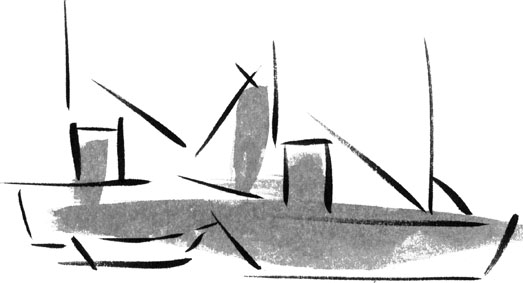 
| (Drawing: Josef Halse)
|
I’ve had my own boats. Of course I started small, with open fjord-fishing-boats. The last one I had was 28 foot with a closed deck. Unfortunately I couldn’t manage the payments due to my own worsening health and my wife’s illness. I’ve also worked for periods as a crew member on other boats. In 1982 the fishing was poor and I saw problems in continuing to work as a fisherman. I applied for a welding course at the technical college in Hammerfest as I wanted to get less demanding work on land. However, I couldn’t put the theory into practice and had to shelve the plan. In the autumn of 1985 I was reported sick and was never declared fit for paid employment again. The sick note led to a full incapacity benefit. I was then 55 years old.
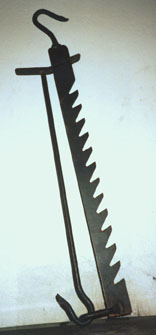
| In the 80s Johan went on a welding course in Hammerfest where, among other things, he made himself this pot-hook. Here he has, with Sami tradition as his starting-point, developed the product further. For, contrary to traditional use, the bottom hook can be turned in relation to the upper part.
(Photo: Svein Lund) |
Due to the difficulties I had writing I had to get a lot of help from others. I’ve had help to fill in my tax declarations and to settle up after the fishing season. People have been incredibly helpful.
I’ve always been interested in union and association work, despite my problems reading and writing. The associations I have served on or been a member of have been local political organizations, Sami organizations and the Sami council, both as leader and committee member at various times. Things have gone relatively well due to good co-operation. I’ve had strong opinions but the problem has been getting these opinions down on paper. Language has also been a hindrance. Organization work has meant a lot to me socially. Through this work I have met others in the same situation and made lots of good friends. It has given me strength, especially now as I am alone.
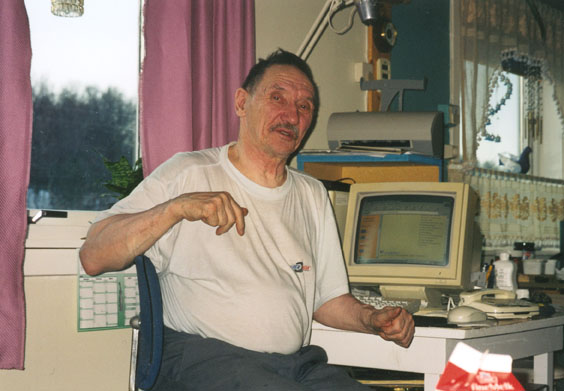
| Johan has, with time, learnt to write Norwegian after a fashion and has also learnt to use a computer.
(Photo: Svein Lund) |
Copy of the Committee on Indemnities’ protocolIn the spring of 1997 Johan Johannessen, through his lawyer Edmund Asbøll, sent in a claim for compensation for lost schooling. Here is the reply he received from the Committee on Indemnities, 18.03.1999. We have reprinted the whole letter, with bold type indicating the parts that show how Norwegianization policy is used as an argument for not giving compensation. When they haven’t even managed to get his name right, something that also other claimants have experienced, it is perhaps a sign of how thorough an individual processing the claims received. Otherwise, the letter speaks for itself.It took two years to get this reply. By then Johan Johannessen had spent thousands of kroner in lawyer’s fees, without getting an øre back. His lawyer informed him that it would cost 5000 kroner to appeal, which Johan couldn’t afford. THE COMMITTEE ON INDEMNITIES JD Case nr. 98/11068 A-AK JCL/kp BU 46/99 - CLAIM FOR INDEMNITY FROM THE TREASURY – JOHAN JOHANSEN, BORN: 04.01.31
Solicitor Edmund Asbøll has, on behalf of Johan Johansen, claimed indemnity from the treasury. The grounds for the claim are lost schooling. We refer to the enclosed claim of 30.04.97.
The Ministry of Justice concurs with the Ministry of Education –Research and Church Affairs’ assessment and conclusion.
Decision: |
More articles from Sami School History 1